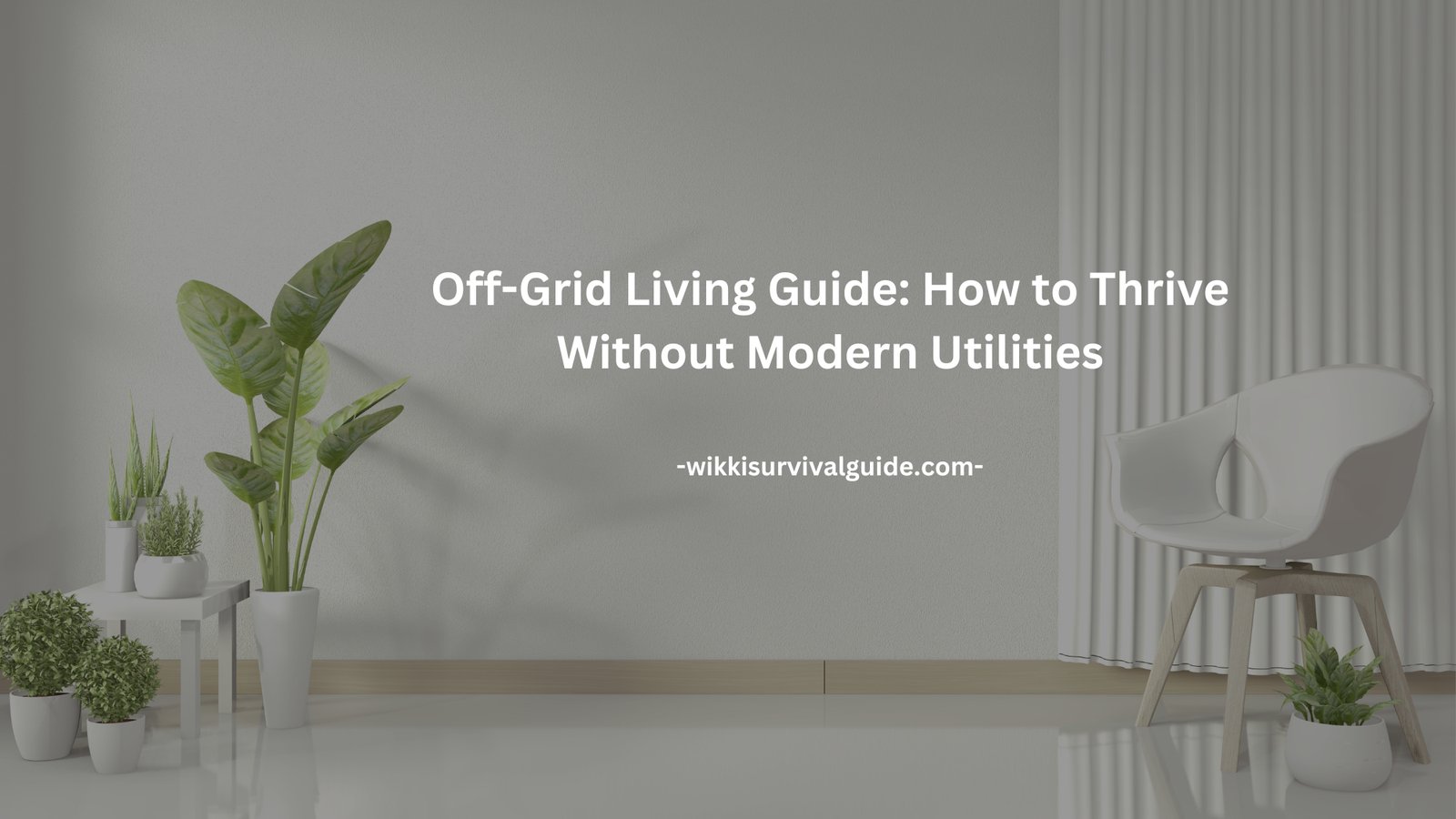Introduction
Living off-grid means disconnecting from traditional utilities like electricity, water, and gas, and relying on self-sufficient systems to meet your needs. It’s a lifestyle that emphasizes independence, sustainability, and a deeper connection to nature. While off-grid living guide can be challenging, it’s also incredibly rewarding. In this comprehensive off-grid living guide, we’ll explore how to thrive without modern utilities, covering everything from energy and water to food and shelter.

What Is Off-Grid Living?
Off-Grid Living Guide: How to Thrive Without Modern Utilities involves creating a self-sufficient lifestyle that operates independently of public utilities. This often includes generating your own power, sourcing your own water, and growing your own food. It’s a way to reduce your environmental impact, save money, and live a simpler, more intentional life.
Benefits of Off-Grid Living
- Independence: Rely on your own resources rather than external systems.
- Sustainability: Reduce your carbon footprint and live more eco-consciously.
- Cost Savings: Lower utility bills and long-term expenses.
- Health and Wellness: Enjoy fresh air, clean water, and organic food.
- Freedom: Escape the hustle and bustle of modern life and reconnect with nature.

Essential Steps to Start Off-Grid Living
1. Choose the Right Location
The location of your off-grid home is critical. Consider:
- Climate: Choose a climate suitable for your needs and goals.
- Land Size: Ensure you have enough space for your projects.
- Water Sources: Access to natural water sources like rivers, lakes, or groundwater is essential.
- Zoning Laws: Check local regulations to ensure off-grid living is allowed.
2. Generate Your Own Power
Energy independence is a cornerstone of off-grid living.
- Solar Power: Install solar panels to harness the sun’s energy.
- Wind Power: Use wind turbines if you live in a windy area.
- Generators: Have a backup generator for emergencies.
- Battery Storage: Store excess energy in batteries for use during cloudy or windless days.
3. Source and Purify Water
Access to clean water is vital.
- Rainwater Harvesting: Collect and store rainwater in barrels or tanks.
- Well Water: Drill a well for a reliable water source.
- Water Purification: Use filters, UV purifiers, or boiling to ensure water safety.
4. Grow Your Own Food
Growing your own food ensures a steady supply of fresh, organic produce.
- Gardening: Start with easy-to-grow vegetables like tomatoes, lettuce, and herbs.
- Permaculture: Design a sustainable garden that mimics natural ecosystems.
- Livestock: Raise chickens, goats, or bees for eggs, milk, and honey.
5. Build or Retrofit Your Home
Your home should be designed for off-grid living.
- Energy-Efficient Design: Use insulation, passive solar heating, and energy-efficient appliances.
- Sustainable Materials: Build with eco-friendly materials like reclaimed wood or straw bales.
- Composting Toilets: Reduce water usage with a composting or dry toilet system.
6. Manage Waste Sustainably
Off-grid living requires responsible waste management.
- Composting: Turn food scraps and yard waste into nutrient-rich compost.
- Recycling: Reuse and recycle materials whenever possible.
- Minimalism: Reduce waste by adopting a minimalist lifestyle.
7. Learn Essential Skills
Off-grid living requires a variety of practical skills.
- Gardening and Food Preservation: Grow and store your own food.
- DIY Repairs: Handle basic carpentry, plumbing, and electrical work.
- First Aid: Be prepared to handle medical emergencies.
Tips for Thriving Off-Grid
- Start Small: Begin with a few projects and gradually expand your off-grid systems.
- Be Resourceful: Use what you have and find creative solutions to challenges.
- Stay Organized: Keep track of maintenance schedules, supplies, and tasks.
- Connect with Others: Join off-grid communities for support and knowledge sharing.
- Be Patient: Off-grid living is a learning process, and mistakes are part of the journey.

Challenges of Off-Grid Living
- Initial Costs: Setting up off-grid systems can be expensive.
- Maintenance: Regular upkeep of systems like solar panels and water filters is required.
- Isolation: Living remotely can be lonely without a strong community.
- Learning Curve: Mastering new skills takes time and effort.
Conclusion
Off-grid living is a fulfilling and sustainable lifestyle that offers independence, resilience, and a deeper connection to nature. By following this off-grid living guide, you can take the first steps toward creating a self-sufficient life without modern utilities.
- Choose the right location and design your home for energy efficiency.
- Generate your own power with solar panels, wind turbines, or generators.
- Source and purify water through rainwater harvesting, wells, or filtration systems.
- Grow your own food and raise livestock for a sustainable Living Guide food supply.
- Learn essential skills like gardening, DIY repairs, and first aid.
FAQs
1. How much does it cost to live off-grid?
Costs vary depending on your setup, but initial investments in solar panels, water systems, and land can be significant.
2. Can I live off-grid in an urban area?
While challenging, urban off-grid living is possible with rooftop gardens, solar panels, and rainwater harvesting.
3. What’s the hardest part of off-grid living?
The learning curve and initial setup can be challenging, but the rewards are worth it.
4. Do I need to be completely self-sufficient to live off-grid?
Not necessarily. Many off-gridders still rely on some external resources, like occasional trips to town for supplies.
5. How do I get started with off-grid living?
Start small with projects like gardening or solar power, and gradually build your skills and systems.
By embracing off-grid living, you can create a more sustainable, independent, and fulfilling lifestyle. Start small, stay committed, and enjoy the journey toward self-sufficiency!




1 Comment